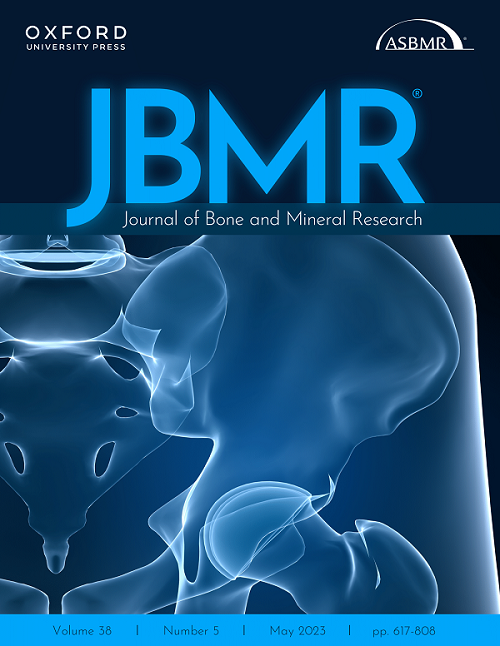Howard A. Fink, Mary E. Butler, Amy M. Claussen, Erin S. Collins, Kristina M. Krohn, Brent C. Taylor, Sina S. Tikabo, Denny Vang, Nicholas L. Zerzan, Kristine E. Ensrud
下载PDF
{"title":"按种族和民族划分的骨折风险评估工具的性能:ASBMR骨折风险临床算法工作组的系统回顾。","authors":"Howard A. Fink, Mary E. Butler, Amy M. Claussen, Erin S. Collins, Kristina M. Krohn, Brent C. Taylor, Sina S. Tikabo, Denny Vang, Nicholas L. Zerzan, Kristine E. Ensrud","doi":"10.1002/jbmr.4895","DOIUrl":null,"url":null,"abstract":"<p>The American Society of Bone and Mineral Research (ASBMR) Professional Practice Committee charged an ASBMR Task Force on Clinical Algorithms for Fracture Risk to review the evidence on whether current approaches for differentiating fracture risk based on race and ethnicity are necessary and valid. To help address these charges, we performed a systematic literature review investigating performance of calculators for predicting incident fractures within and across race and ethnicity groups in middle-aged and older US adults. We included English-language, controlled or prospective cohort studies that enrolled US adults aged >40 years and reported tool performance predicting incident fractures within individual race and ethnicity groups for up to 10 years. From 4838 identified references, six reports met eligibility criteria, all in women. Just three, all from one study, included results in non-white individuals. In these three reports, non-white women experienced relatively few major osteoporotic fractures (MOFs), especially hip fractures, and risk thresholds for predicting fractures in non-white women were derived from risks in the overall, predominantly white study population. One report suggested the Fracture Risk Assessment Tool (FRAX) without bone mineral density (BMD) overestimated hip fracture similarly across race and ethnicity groups (black, Hispanic, American Indian, Asian, white) but overestimated MOF more in non-white than White women. However, these three reports were inconclusive regarding whether discrimination of FRAX or the Garvan calculator without BMD or of FRAX with BMD for MOF or hip fracture differed between white versus black women. This uncertainty was at least partly due to imprecise hip fracture estimates in black women. No reports examined whether ratios of observed to predicted hip fracture risks within each race or ethnicity group varied across levels of predicted hip fracture risk. © 2023 The Authors. <i>Journal of Bone and Mineral Research</i> published by Wiley Periodicals LLC on behalf of American Society for Bone and Mineral Research (ASBMR). This article has been contributed to by U.S. Government employees and their work is in the public domain in the USA.</p>","PeriodicalId":185,"journal":{"name":"Journal of Bone and Mineral Research","volume":"38 12","pages":"1731-1741"},"PeriodicalIF":5.9000,"publicationDate":"2023-08-19","publicationTypes":"Journal Article","fieldsOfStudy":null,"isOpenAccess":false,"openAccessPdf":"https://onlinelibrary.wiley.com/doi/epdf/10.1002/jbmr.4895","citationCount":"0","resultStr":"{\"title\":\"Performance of Fracture Risk Assessment Tools by Race and Ethnicity: A Systematic Review for the ASBMR Task Force on Clinical Algorithms for Fracture Risk\",\"authors\":\"Howard A. Fink, Mary E. Butler, Amy M. Claussen, Erin S. Collins, Kristina M. Krohn, Brent C. Taylor, Sina S. Tikabo, Denny Vang, Nicholas L. Zerzan, Kristine E. Ensrud\",\"doi\":\"10.1002/jbmr.4895\",\"DOIUrl\":null,\"url\":null,\"abstract\":\"<p>The American Society of Bone and Mineral Research (ASBMR) Professional Practice Committee charged an ASBMR Task Force on Clinical Algorithms for Fracture Risk to review the evidence on whether current approaches for differentiating fracture risk based on race and ethnicity are necessary and valid. To help address these charges, we performed a systematic literature review investigating performance of calculators for predicting incident fractures within and across race and ethnicity groups in middle-aged and older US adults. We included English-language, controlled or prospective cohort studies that enrolled US adults aged >40 years and reported tool performance predicting incident fractures within individual race and ethnicity groups for up to 10 years. From 4838 identified references, six reports met eligibility criteria, all in women. Just three, all from one study, included results in non-white individuals. In these three reports, non-white women experienced relatively few major osteoporotic fractures (MOFs), especially hip fractures, and risk thresholds for predicting fractures in non-white women were derived from risks in the overall, predominantly white study population. One report suggested the Fracture Risk Assessment Tool (FRAX) without bone mineral density (BMD) overestimated hip fracture similarly across race and ethnicity groups (black, Hispanic, American Indian, Asian, white) but overestimated MOF more in non-white than White women. However, these three reports were inconclusive regarding whether discrimination of FRAX or the Garvan calculator without BMD or of FRAX with BMD for MOF or hip fracture differed between white versus black women. This uncertainty was at least partly due to imprecise hip fracture estimates in black women. No reports examined whether ratios of observed to predicted hip fracture risks within each race or ethnicity group varied across levels of predicted hip fracture risk. © 2023 The Authors. <i>Journal of Bone and Mineral Research</i> published by Wiley Periodicals LLC on behalf of American Society for Bone and Mineral Research (ASBMR). This article has been contributed to by U.S. Government employees and their work is in the public domain in the USA.</p>\",\"PeriodicalId\":185,\"journal\":{\"name\":\"Journal of Bone and Mineral Research\",\"volume\":\"38 12\",\"pages\":\"1731-1741\"},\"PeriodicalIF\":5.9000,\"publicationDate\":\"2023-08-19\",\"publicationTypes\":\"Journal Article\",\"fieldsOfStudy\":null,\"isOpenAccess\":false,\"openAccessPdf\":\"https://onlinelibrary.wiley.com/doi/epdf/10.1002/jbmr.4895\",\"citationCount\":\"0\",\"resultStr\":null,\"platform\":\"Semanticscholar\",\"paperid\":null,\"PeriodicalName\":\"Journal of Bone and Mineral Research\",\"FirstCategoryId\":\"3\",\"ListUrlMain\":\"https://onlinelibrary.wiley.com/doi/10.1002/jbmr.4895\",\"RegionNum\":1,\"RegionCategory\":\"医学\",\"ArticlePicture\":[],\"TitleCN\":null,\"AbstractTextCN\":null,\"PMCID\":null,\"EPubDate\":\"\",\"PubModel\":\"\",\"JCR\":\"Q1\",\"JCRName\":\"ENDOCRINOLOGY & METABOLISM\",\"Score\":null,\"Total\":0}","platform":"Semanticscholar","paperid":null,"PeriodicalName":"Journal of Bone and Mineral Research","FirstCategoryId":"3","ListUrlMain":"https://onlinelibrary.wiley.com/doi/10.1002/jbmr.4895","RegionNum":1,"RegionCategory":"医学","ArticlePicture":[],"TitleCN":null,"AbstractTextCN":null,"PMCID":null,"EPubDate":"","PubModel":"","JCR":"Q1","JCRName":"ENDOCRINOLOGY & METABOLISM","Score":null,"Total":0}
引用次数: 0
引用
批量引用


 求助内容:
求助内容: 应助结果提醒方式:
应助结果提醒方式:


